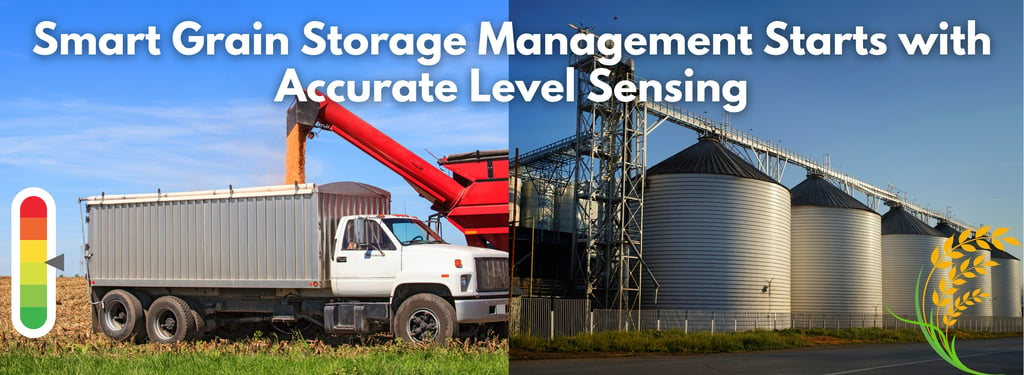Revolutionize Your Tracking Experience – Real Time, Reliable & Effortless tracking solutions
+91 - 7665666631 (Toll Free)
Grain Level Sensor: Revolutionizing Grain Storage Management with Precision and Intelligence
In this detailed blog, explore everything about grain level sensors—how they work, their types, benefits, key features, applications, and how they help modernize grain storage and inventory management. Learn why grain level sensors are becoming essential tools for agribusinesses, warehouses, and grain processing industries.
Chandra Singh
5/15/20253 min read


In the agricultural and grain processing industries, efficient inventory management is not just about knowing how much grain you have—it's about ensuring the safety, quality, and profitability of your stock. Traditional methods of measuring grain levels, such as manual probing or visual estimation, are time-consuming, labour-intensive, and prone to errors. Enter the Grain Level Sensor, a modern-day solution for real-time, accurate, and automated grain level monitoring.
In this blog, we will take an in-depth look into grain level sensors—how they work, their importance, types, benefits, key features, and how they can help industries optimize their operations.
What is a Grain Level Sensor?
A Grain Level Sensor is an electronic device designed to measure and monitor the level of grain stored in silos, bins, warehouses, or tanks. These sensors provide real-time data on the amount of grain available, helping businesses make informed decisions regarding procurement, sales, logistics, and stock management.
These devices can detect the level of various grains such as wheat, rice, maize, barley, pulses, and oilseeds, among others. Advanced grain level sensors offer remote monitoring capabilities, integrating with cloud-based platforms, mobile apps, or centralized dashboards for seamless inventory control.
Why is Grain Level Monitoring Important?
Grain is a sensitive commodity that can spoil, degrade, or attract pests if not stored properly. Here's why accurate grain level monitoring is crucial:
Prevent Overstocking or Shortages: Real-time level monitoring ensures you always know your stock levels and plan procurement or sales accordingly.
Avoid Spoilage & Quality Loss: By monitoring grain levels, you can optimize the turnover cycle and prevent over-storage which may lead to quality degradation.
Enhanced Safety: Prevents hazardous situations like silo overflows, which can cause accidents or financial losses.
Improved Logistics Planning: Accurate data enables smoother coordination of dispatches, procurement, and warehouse space management.
Cost Optimization: Reduces manpower dependency, minimizes wastage, and optimizes operational costs.
How Does a Grain Level Sensor Work?
Grain level sensors typically use one of several sensing technologies to detect the level of stored grain:
1. Ultrasonic Level Sensors
Work by emitting ultrasonic waves from the sensor to the grain surface.
The time taken for the wave to reflect back is measured to calculate the grain level.
Non-contact and highly reliable.
2. Radar Level Sensors
Utilize radar waves (either 24GHz or 80GHz) to determine the grain level.
Excellent performance even in dusty, humid, or vapor-filled silo conditions.
Ideal for tall silos or complex storage structures.
3. Capacitive Level Sensors
Use changes in capacitance to detect the presence or absence of grain at certain levels.
More suited for point-level detection than continuous measurement.
4. Laser Level Sensors
Use laser beams to detect grain level with high precision.
Not commonly used in very dusty environments unless combined with air purging.
Key Features of a Modern Grain Level Sensor
Real-Time Monitoring: Provides live updates of grain levels 24x7.
Remote Accessibility: View grain levels on mobile apps, web dashboards, or through cloud platforms.
Customizable Alerts: Get notifications for low levels, high levels, or abnormal patterns.
Integration Capability: Compatible with existing warehouse management systems, ERP, or farm management software.
Multi-Point Sensing: For large silos, some sensors provide multi-point measurement to avoid blind spots.
Battery-Powered or Solar Options: Ensures installation flexibility in remote or power-deficient areas.
Data Logging & Reporting: Historical data storage for analysis and audit purposes.
Durability: Resistant to dust, pests, temperature fluctuations, and harsh silo environments.
Benefits of Using Grain Level Sensors
1. Operational Efficiency
Grain level sensors automate the entire stock-checking process, freeing up manpower and ensuring quicker, more accurate inventory updates.
2. Enhanced Inventory Management
Provides accurate data that helps plan procurement, dispatch, and sales, reducing inventory carrying costs and preventing stockouts.
3. Quality Preservation
Helps in rotating stock timely and avoiding conditions that lead to spoilage, pest attacks, or fungal growth.
4. Cost Savings
Minimizes manual labour, reduces wastage due to overfilling or spoilage, and prevents emergency procurement costs.
5. Safety & Compliance
Maintains safer storage practices, reduces the risk of silo overflows, and aids in maintaining compliance with food safety and storage regulations.
Applications of Grain Level Sensors
Grain level sensors find applications across various industries and sectors:
Grain Silos & Storage Warehouses
Agri Co-operatives & Farmer Producer Organizations (FPOs)
Flour Mills, Rice Mills, Oilseed Processing Units
Animal Feed Plants
Port Storage Facilities & Bulk Grain Export Hubs
Government Food Storage Warehouses (like FCI warehouses in India)
Logistics & Supply Chain Companies dealing with grain transportation
How to Choose the Right Grain Level Sensor?
When selecting a grain level sensor, consider the following factors:
Type of Grain and Its Behaviour (flowability, dustiness, etc.)
Silo Dimensions & Shape
Environmental Conditions (dust, humidity, temperature)
Accuracy Requirements
Integration Needs with Existing Systems
Budget and Maintenance Preferences
The Future of Grain Storage: Smart, Data-Driven & Sustainable
As global grain production and trade expand, efficient storage management becomes pivotal for food security and profitability. Grain level sensors are no longer a luxury but a necessity for modern agribusinesses. By automating grain level monitoring, companies can eliminate guesswork, reduce losses, and enhance safety and profitability.
With the integration of IoT (Internet of Things), AI-based analytics, and cloud technology, grain level sensors are evolving into intelligent devices that not only monitor levels but also provide actionable insights to optimize the entire grain supply chain.
Empowering Your Journey with Smart Tracking!
Fleet or Personal, We Track It All – Get in Touch
support@alitegps.com
Srag India Info Solutions © 2025. All rights reserved.
Info@alitegps.com
